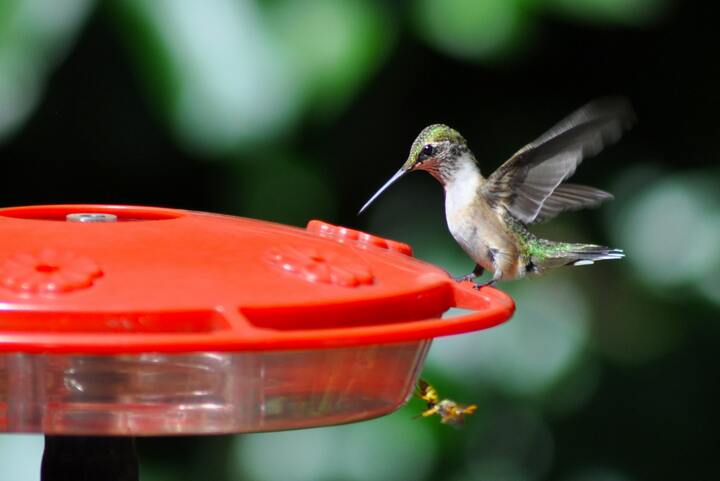Migrating Hummingbirds Don't Take Your Feeders Down Too Soon
Even if you haven't attracted hummingbirds to your garden this summer, it's essential to keep your hummingbird feeders available.
Hummingbirds require increased nourishment before migrating to their wintering grounds.
Let's discuss the importance of providing hummingbird feeders and some suggestions on when to take your hummingbird feeders down.
Migrating Hummingbirds and Nectar Feeders
Many birders report seeing hummingbirds in their yards and feeders until early October or even later.
Keeping your nectar feeders available during this time provides an essential source of nourishment that hummingbirds need to survive their long migration journey.

Hummingbird at Feeder
Contrary to popular belief, providing hummingbird feeders does not encourage hummingbirds to stay longer than necessary.
The majority of hummingbird species spend their entire lives within 20 miles of where they were born.
However, rufous and ruby-throated hummingbirds are two species known for their extensive migration patterns.
The rufous hummingbird nests as far north as southern Alaska and then flies 2,500 miles to Central America for the winter.
Ruby-throated hummingbirds travel approximately 2,000 miles twice each year between their breeding and wintering sites.
Remarkably, juvenile ruby-throated hummingbirds make the flight across the Gulf of Mexico to southern Mexico or Central America without guidance from their parents.
Although they may find a group of adults that have made the flight before, it is a leap of faith for these young birds to follow their instincts and leave the safety of land for the long flight over open water.
The length of daylight hours triggers hormonal changes in hummingbirds, prompting them to put on the extra weight necessary to sustain them for their long journey.
Before migrating, hummingbirds enter a phase called hyperphagia, a feeding frenzy during which they spend more time than usual ingesting nectar and insects.
They add 50% to 100% of their normal body weight for fuel for the migratory exertion.
So When Do You Take Your Hummingbird Feeders Down?
The primary reason to take down hummingbird feeders is the seasonal migration of these birds.
Hummingbirds typically migrate to warmer climates during the fall and return in the spring.
In North America, this usually occurs between late August and early October, depending on the species and location.
However, there are other times you may want to consider removing your feeders. Following are some things to consider.
Decreased Hummingbird Activity
Monitor the activity around your feeders to determine when it's time to take them down.
If you notice a significant decrease in hummingbird visits, it may be an indication that they have begun their migration or found alternative food sources.
I like to wait at least two weeks after I've seen a hummingbird before taking down any of my feeders.
End of Breeding Season
The end of the breeding season is another time to consider taking down hummingbird feeders. This typically occurs in late summer or early fall.
Removing feeders at this time can help encourage young hummingbirds to learn how to forage for natural food sources, such as nectar-producing flowers and insects, which are essential for their survival.
I would choose this time if the household gets busy with back-to-school activities and feeders are getting neglected. Also, if you plan on travelling at this time of year.
Freezing Temperatures
Maybe obvious, but you want to take down hummingbird feeders if freezing temperatures are forecasted. But hold on, sometimes Hummingbirds are still around.
Early freezes with returning seasonal temperatures occur. And just like us, hummingbirds get caught off guard. Late migrators may come through as well.
So take your feeder in a night and return it as early as you can if temps are going to rebound.
Debunking Migration Myths
A popular myth suggests that hummingbirds ride on the backs of geese or other birds when migrating. This is not true.
Hummingbirds are strong fliers and rely on their own abilities to complete their migration journey.
Final Thoughts
Keeping nectar feeders available for migrating hummingbirds is crucial for their survival during their long journey to their wintering grounds.
By providing an additional source of nourishment, you can help support these tiny birds as they embark on their incredible migration.
Check our a few Gift Ideas for Hummingbird Lovers





